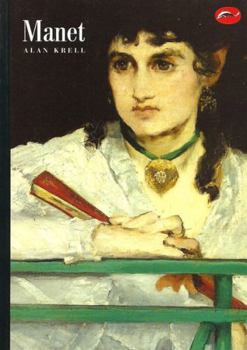Manet
(Part of the World of Art Series and World of Art Series)
There are some great painters whose influence is confined to the world of painting--others whose impact is felt more widely, who through their art are effectively moral critics, challenging the society in which they live. Manet was one of these. Rejecting the traditional 'histories' and 'mythologies' that won official acclaim, he turned instead to the life of his own time.
Yet he did not ally himself with the other painters of contemporary life, the Impressionists, preferring to engage with a Realist tradition, and at the same time drawing on the art of the past--Raphael, Titian, Velazquez, Goya - to confront his own age. It was a provocative program and one which baffled the establishment.
In this freshly researched study Dr Alan Krell examines the artist's known intentions and the critical, sometimes bitterly hostile reception that he encountered. He sets Manet against Impressionists like Monet, Degas and Morisot, and shows how the artist's progressive social views - on sexuality, on the position of women, on the family--were expressed through a style equally 'modern', yet rooted in the European artistic tradition.
Yet he did not ally himself with the other painters of contemporary life, the Impressionists, preferring to engage with a Realist tradition, and at the same time drawing on the art of the past--Raphael, Titian, Velazquez, Goya - to confront his own age. It was a provocative program and one which baffled the establishment.
In this freshly researched study Dr Alan Krell examines the artist's known intentions and the critical, sometimes bitterly hostile reception that he encountered. He sets Manet against Impressionists like Monet, Degas and Morisot, and shows how the artist's progressive social views - on sexuality, on the position of women, on the family--were expressed through a style equally 'modern', yet rooted in the European artistic tradition.
Format:Paperback
Language:English
ISBN:0500202893
ISBN13:9780500202890
Release Date:April 1996
Publisher:Thames & Hudson
Length:208 Pages
Weight:1.00 lbs.
Dimensions:0.6" x 5.9" x 8.3"
Customer Reviews
2 ratings
Very good at many points, but lacks comprehensive overview
Published by Thriftbooks.com User , 21 years ago
I highly recommend this book to anyone interested in Edoard Manet. Although T. J. Clark's masterful THE PAINTING OF MODERN LIFE is the most essential study of Manet in English, it functions better as a theoretical treatise on politics and the philosophy of art than as an introduction to Manet's art. But Clark's work keeps in sight something that Krell's work never achieves: a sense of the overall point of Manet's art.I find overall that Krell discussed quite well various specifics in Manet's work. He is especially good at covering at an introductory level many aspects of particular paintings, and was outstanding at articulating the response of Manet's contemporaries to each work. Like many recent art historians, Krell does a great job of informing the reader of where each major work was originally shown. Previous generations of art historians ignored the context for the public debut of paintings, as if all work was created in an ahistorical vortex divorced from the real world. What keeps me from giving this book five stars is the lack of any kind of overview of Manet's greater historical significance, and specifically how he helped change the history of art (and change it he certainly did). From reading other works one will learn that Manet was a key figure--in fact, one of the key figures--in moving painting from historical and allegorical subjects to every day subjects. But Krell hardly alludes to this, although its having been the case underlies nearly everything he writes about Manet. There is furthermore absolutely no effort to distinguish Manet from the Impressionists and the painters who followed in his wake. He might cover the way that Manet treats cafe life in contrast to Degas, or he might allude to the fact that Manet rarely painted in plain air unlike the Impressionists, but all in all he does not do an especially good job of explaining what made Manet unique. On the other hand, I found his frequent allusions to the social alienation of the characters in Manet's paintings to be very helpful. Although I was previously familiar with Manet's paintings, I had never before been made aware of the degree to which the various individuals in his paintings fail to interact with one another. Manet emerges not merely as the recorder of social life of his time, but witness to the social alienation inherent in modern life.
Does what it's supposed to do
Published by Thriftbooks.com User , 22 years ago
This book is very brief -- about two hundred pages, but only about one-third of that is text -- but it accomplishes what in my view a book of this sort should do: it makes clear, on an introductory level, why Manet is an important painter and what his innovations were. Many books of this sort dwell on insignificant trivia surrounding the artist and his work, without engaging in any real analysis. This one doesn't do that; the basics of Manet's significance as an artist are made clear. It is also very readable and unpretentious. Having said that, it does have some flaws. It tends to lose focus toward the end, and to meander somewhat. Discussion of Impressionist artists, ostensibly for purposes of comparison with Manet, seem excessive and tangential at times. And a bit more discussion of Manet's relationship to Realists such as Courbet would have been welcome. Nevertheless, a worthwhile investment of time and money. Some good reproductions as well.






